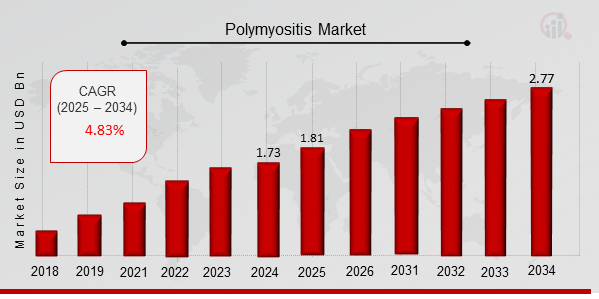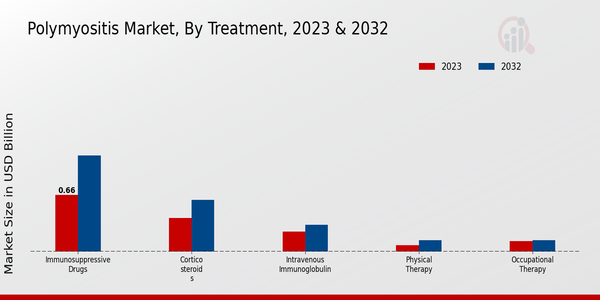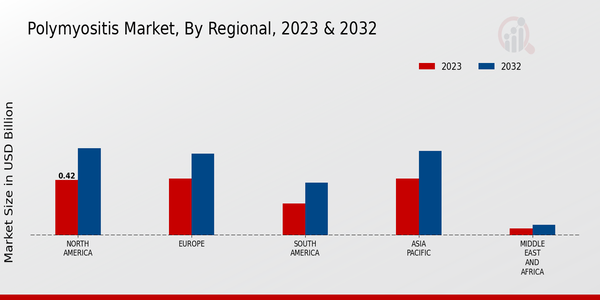Global Polymyositis Market Overview
As per MRFR analysis, the Polymyositis Market Size was estimated at 1.73 (USD Billion) in 2024. The Polymyositis Market Industry is expected to grow from 1.81 (USD Billion) in 2025 to 2.77 (USD Billion) till 2034, at a CAGR (growth rate) is expected to be around 4.83% during the forecast period (2025 - 2034).
Key Polymyositis Market Trends Highlighted
The rising prevalence of autoimmune diseases, advancements in diagnosis and treatment modalities, and the growing demand for personalized medicine are key drivers of the Polymyositis market. Opportunities exist in the development of novel therapies, such as immunomodulators and targeted therapies, and the expansion into emerging markets.
Recent trends include the increasing use of biomarkers for early diagnosis and personalized treatment, the development of non-invasive diagnostic techniques, and the growing awareness of the disease among healthcare professionals and the public.

Source: Primary Research, Secondary Research, MRFR Database and Analyst Review
Polymyositis Market Drivers
Rising Prevalence of Autoimmune Disorders
Polymyositis is an autoimmune disorder that causes inflammation and weakness in the muscles. The rising prevalence of autoimmune disorders is a major driver of the growth of the Global Polymyositis Market Industry. According to the American Autoimmune Related Diseases Association (AARDA), approximately 23.5 million Americans are affected by an autoimmune disease.
This number is expected to grow in the coming years as the population ages and environmental factors contribute to the development of these conditions. As the prevalence of autoimmune disorders increases, so too will the demand for treatments for polymyositis.
Growing Awareness of Polymyositis
Another key driver of the Global Polymyositis Market Industry is the growing awareness of the condition. In the past, polymyositis was often misdiagnosed or undiagnosed. However, with the advent of new diagnostic techniques and the development of more effective treatments, more and more people are being diagnosed with polymyositis. This increased awareness is leading to a greater demand for treatments and services for polymyositis patients.
Development of New Therapies
The Global Polymyositis Market Industry is also on an upswing owing to the development of new therapies. Over the past few years, several new drugs have been cleared for the treatment of polymyositis. These drugs have proven to be beneficial in ameliorating the symptoms of the condition.
Furthermore, they have demonstrated efficacy in slowing the progress of polymyositis. Given that these therapies perform their intended purpose, it is reasonable to expect that demand is likely to rise as more effective treatments are developed.
Polymyositis Market Segment Insights
Polymyositis Market Treatment Insights
The Global Polymyositis Market segmentation is anticipated to expand vastly by 2032. The Treatment segment has a positive impact on the market, and it involves different approaches that are used to treat Polymyositis. Immunosuppressive Drugs suppress the immune systems to prevent muscle inflammation, and the market size will reach $USD 650 million by 2032.
Corticosteroids involve drugs such as prednisone aimed at reducing inflammation and pain, and the expected market value contribution will be $USD 380 million by 2032. Intravenous Immunoglobulin supplements the immune system since it contains antibodies and the value is expected to reach $USD 220 million by 2032.
Physical Therapy helps the affected patients in participating in exercises and stretches to improve muscle strength and mobility. The contribution will be $USD 140 million by 2032. Occupational Therapy assists these patients in performing daily living activities and developing adaptive strategies. The value is expected to be $USD 120 million by 2032.
Speech Therapy helps in solving communication problems caused by muscle weakness, and the market value is expected to be $USD 100 million by 2032. The growth of this segment is being influenced by the increased prevalence of Polymyositis patients, increased healthcare costs, and due to the advancement in the methods used in treating this condition.

Source: Primary Research, Secondary Research, MRFR Database and Analyst Review
Polymyositis Diagnosis Insights
To diagnose Polymyositis Market, a combination of clinical examination, laboratory tests, and imaging techniques is required. Some of the common diagnostic procedures of Polymyositis Market include: Physical Examination During a physical examination, the healthcare professional looks for muscle weakness, tenderness, and swelling. The physician may also check the range of motion and strength of the muscle. Muscle Biopsy A muscle biopsy refers to removing a small piece of muscle tissue under a microscope, which can determine the diagnosis of Polymyositis Market.
The microscopic examination will show signs of inflammation and muscle damage. Electromyography Normally referred to as EMG, an electromyogram is a diagnostic imaging technique that measures the electrical activity of the muscle. This procedure helps differentiate between Polymyositis Market and other musculoskeletal and neuromuscular problems. Blood Tests The blood test helps identify the levels of the enzyme creatine kinase, or CK, which is secreted into the bloodstream when the muscle is damaged.
Other blood tests will check for the autoantibodies that develop in the affected person’s body. Magnetic Resonance Imaging or MRI visualizes the muscles and surrounding tissue, when magnetic fields and radiofrequency waves are used; the procedure gives a comprehensive detailed image. The market growth is due to the increasing prevalence of autoimmune diseases, rising awareness of the Polymyositis Market, and technological advancements in diagnostics.
Polymyositis Type Insights
Idiopathic Polymyositis is the most common type of Polymyositis, accounting for over 50% of cases. Dermatomyositis is the second most common type, accounting for around 25% of cases. Inclusion Body Myositis is a rare type of Polymyositis, accounting for less than 5% of cases. Overlapping Myositis Syndromes is a group of rare conditions that share features of Polymyositis and other autoimmune diseases. The market growth is attributed to the increasing prevalence of autoimmune diseases, growing awareness of Polymyositis, and the availability of new and effective treatments.
Polymyositis Severity Insights
The severity of polymyositis can vary widely, ranging from mild to severe. The Global Polymyositis Market segmentation by severity provides valuable insights into the market dynamics and treatment patterns. In 2023, the mild severity segment accounted for the largest share of the Global Polymyositis Market revenue, with a market size of approximately USD 0.9 billion. This dominance can be attributed to the higher prevalence of mild cases, where symptoms are less severe and often manageable with conservative treatment approaches.
The moderate severity segment is expected to witness steady growth, owing to the increasing awareness about the condition and advancements in treatment options.The severe severity segment, though accounting for a smaller market share, represents a significant unmet medical need. These patients often require intensive treatment and may experience long-term complications, driving the demand for specialized care and novel therapies. Understanding the severity segmentation of the Global Polymyositis Market is crucial for developing targeted treatment strategies, optimizing resource allocation, and addressing the specific needs of patients with varying disease severity.
Polymyositis Regional Insights
The regional segmentation of the Global Polymyositis Market provides insights into the market's geographic distribution and growth potential. North America holds a significant share of the market due to the presence of well-established healthcare infrastructure, high awareness of the disease, and access to advanced treatment options. Europe follows closely, with a large patient population and a focus on research and development.
The APAC region is expected to witness substantial growth in the coming years, driven by factors such as rising healthcare expenditure and increasing awareness of the disease.South America and MEA have a relatively smaller market share but are expected to show steady growth due to the increasing adoption of modern healthcare practices and government initiatives to improve healthcare access. Overall, the Global Polymyositis Market is expected to continue its growth trajectory in the coming years, driven by unmet medical needs and the development of novel therapies and treatment approaches.

Source: Primary Research, Secondary Research, MRFR Database and Analyst Review
Polymyositis Market Key Players And Competitive Insights
Major players in the Polymyositis Market industry are continuously focusing on developing novel and effective treatment options for polymyositis. These players are investing heavily in research and development activities to enhance their product portfolio and gain a competitive edge in the market. Leading Polymyositis Market players are also actively involved in strategic collaborations, partnerships, and acquisitions to expand their global reach and strengthen their market position.
The Polymyositis Market industry is highly fragmented, with several small and medium-sized players operating alongside large multinational corporations. Key industry participants are adopting various growth strategies, including product launches, partnerships, and acquisitions, to expand their market share and cater to the evolving needs of patients. Ongoing advancements in research and development are expected to drive future Polymyositis Market development, leading to the introduction of more effective and targeted therapies.AbbVie Inc. is a global biopharmaceutical company headquartered in North Chicago, Illinois,
United States. It is a leading player in the Polymyositis Market and has a strong focus on immunology, oncology, virology, and neuroscience. AbbVie's product portfolio includes Humira, Imbruvica, and Skyrizi, which are used to treat various autoimmune conditions, including polymyositis. The company has a robust pipeline of potential treatments for polymyositis and is committed to developing innovative therapies that improve patient outcomes. AbbVie's strong financial position and global reach enable it to invest heavily in research and development, ensuring its continued leadership in the Polymyositis Market.Pfizer Inc. is a multinational pharmaceutical and biotechnology corporation headquartered in New York City, United States.
It is a leading player in the Polymyositis Market and has a diversified portfolio of products for various therapeutic areas. Pfizer's involvement in the Polymyositis Market includes the development and commercialization of Xeljanz, which is an oral medication used to treat rheumatoid arthritis, psoriatic arthritis, and ulcerative colitis. The company is also actively involved in research and development programs to expand its product portfolio for polymyositis and other autoimmune diseases. Pfizer's strong brand recognition, global presence, and commitment to innovation position it as a key competitor in the Polymyositis Market.
Key Companies in the Polymyositis Market Include
- Astellas Pharma
- Roche
- Mitsubishi Tanabe Pharma Corporation
- AbbVie
- GlaxoSmithKline
- Sanofi
- Pfizer
- Bayer
- Teva Pharmaceutical Industries
- Celgene
- Novartis
- AstraZeneca
- Eli Lilly and Company
- Merck
- Johnson Johnson
Polymyositis Market Industry Developments
The global Polymyositis Market is anticipated to witness substantial growth over the forecast period, driven by the rising prevalence of autoimmune diseases, increasing healthcare expenditure, and growing awareness about Polymyositis. Advancements in diagnostic techniques and the development of novel therapeutic options are further contributing to market expansion.
Key players are focusing on strategic collaborations, acquisitions, and research and development initiatives to strengthen their market position. Recent developments include the approval of new therapies, such as Rituximab and Abatacept, for the treatment of Polymyositis. The market is expected to witness the emergence of personalized medicine and targeted therapies, further driving growth in the coming years.
Polymyositis Market Segmentation Insights
Polymyositis Treatment Outlook
- Immunosuppressive Drugs
- Corticosteroids
- Intravenous Immunoglobulin (IVIG)
- Physical Therapy
- Occupational Therapy
- Speech Therapy
Polymyositis Diagnosis Outlook
- Physical Examination
- Muscle Biopsy
- Electromyography (EMG)
- Blood Tests
- Magnetic Resonance Imaging (MRI)
Polymyositis Type Outlook
- Idiopathic Polymyositis
- Dermatomyositis
- Inclusion Body Myositis
- Overlapping Myositis Syndromes
Polymyositis Severity Outlook
Polymyositis Regional Outlook
- North America
- Europe
- South America
- Asia Pacific
- Middle East and Africa
| Report Attribute/Metric |
Details |
|
Market Size 2024
|
1.73 (USD Billion)
|
|
Market Size 2025
|
1.81 (USD Billion)
|
|
Market Size 2034
|
2.77 (USD Billion)
|
|
Compound Annual Growth Rate (CAGR)
|
4.83 % (2025 - 2034)
|
|
Report Coverage
|
Revenue Forecast, Competitive Landscape, Growth Factors, and Trends
|
|
Base Year
|
2024
|
|
Market Forecast Period
|
2025 - 2034
|
|
Historical Data
|
2020 - 2024
|
| Market Forecast Units |
USD Billion |
| Key Companies Profiled |
Astellas Pharma, Roche, Mitsubishi Tanabe Pharma Corporation, AbbVie, GlaxoSmithKline, Sanofi, Pfizer, Bayer, Teva Pharmaceutical Industries, Celgene, Novartis, AstraZeneca, Eli Lilly and Company, Merck Co., Johnson Johnson |
| Segments Covered |
Treatment, Diagnosis, Type, Severity, Regional |
| Key Market Opportunities |
Development of novel therapies Growing awareness Rising prevalence Technological advancements Untapped emerging markets |
| Key Market Dynamics |
Rising prevalence of autoimmune diseases Increasing research and development activities Growing demand for targeted therapies |
| Countries Covered |
North America, Europe, APAC, South America, MEA |
Frequently Asked Questions (FAQ) :
The Polymyositis Market is anticipated to reach an approximate valuation of 1.57 billion USD in 2023.
The Polymyositis Market is estimated to exhibit a CAGR of 4.83% during the forecast period from 2025 to 2034.
By the end of the forecast period in 2032, the Polymyositis Market is projected to reach a valuation of approximately 2.4 billion USD.
North America is anticipated to dominate the Polymyositis Market throughout the forecast period.
The major application segments of the Polymyositis Market include Pharmaceuticals, Immunosuppressants, and Steroids.
Some of the key competitors in the Polymyositis Market include Pfizer, Merck, and Novartis.
The Pharmaceuticals segment of the Polymyositis Market is anticipated to generate revenue of approximately 1 billion USD in 2023.
The Immunosuppressants segment of the Polymyositis Market is estimated to exhibit a CAGR of 4.83% during the forecast period from 2025 to 2034.
The Asia-Pacific region is anticipated to witness the highest growth rate in the Polymyositis Market during the forecast period.
By the end of 2032, the Steroids segment of the Polymyositis Market is projected to reach a valuation of approximately 0.5 billion USD.

















